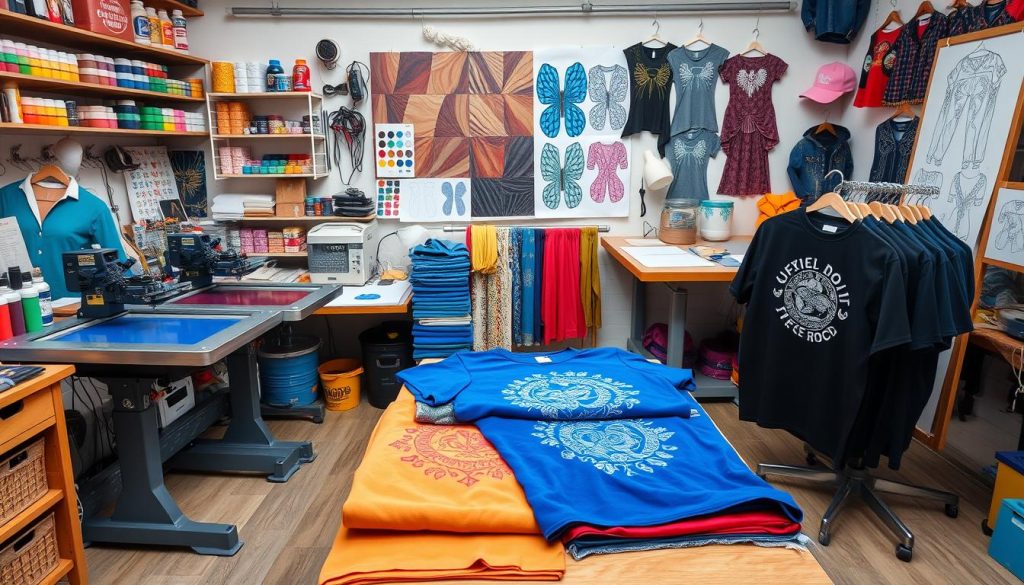When you’re looking to create custom clothing, screen printing and embroidery stand out as the two most popular decoration methods available today. Each technique brings its own unique advantages to the table, significantly influencing the final appearance, texture, and overall cost of your custom garments. Understanding the key differences between these methods becomes absolutely crucial whether you’re a business owner seeking branded merchandise or an individual wanting to create personalized clothing that truly stands out.
This comprehensive guide will take you through everything you need to know about embroidery vs screen printing, covering the fundamental processes, industry best practices, and real-world applications of each method. By the time you finish reading, you’ll have a clear understanding of which decoration technique aligns perfectly with your specific needs, budget constraints, and creative vision.
Table of Contents
Understanding Decoration Methods for Custom Apparel
In the dynamic world of custom apparel creation, the decoration techniques you choose will fundamentally determine the final appearance, longevity, and overall market appeal of your finished products. Screen printing and embroidery have emerged as the two most popular methods in the industry, with each technique offering its own unique set of advantages and specific applications that make them suitable for different types of projects.
Basic Principles of Garment Decoration
Screen printing operates on a relatively straightforward principle that involves forcing ink through a specially prepared mesh screen onto the fabric surface below. This technique proves particularly effective for creating bold, eye-catching designs on popular garments like t-shirts, hoodies, and other casual wear items where vibrant colors and sharp graphics are desired.
Embroidery, in contrast, takes a completely different approach by using specialized threads to create intricate patterns, logos, and text directly on the fabric surface. This method excels at adding a distinctly professional and premium touch to workwear, corporate uniforms, and high-end branded apparel where quality and sophistication are paramount.
Industry Standards and Applications
The apparel decoration industry has established comprehensive standards that govern the quality expectations for both screen printing and embroidery work. These standards encompass everything from ink selection and mesh counts in screen printing to thread types, stitch densities, and pattern complexity in embroidery work.
Understanding these established industry standards becomes crucial for brands and decoration professionals who want to consistently produce high-quality garments that not only meet but exceed their target audience’s expectations and requirements.
| Decoration Technique | Ideal Applications | Fabric Compatibility |
| Screen Printing | Casual wear (t-shirts, hoodies), Event and promotional apparel, Sportswear and activewear | Cotton, Polyester, Blended fabrics |
| Embroidery | Corporate and professional attire, Workwear and uniforms, Luxury and premium apparel | Cotton, Twill, Denim, Polyester |

What is Screen Printing: Process and Technology
Screen printing, also commonly referred to as silk screening in certain circles, has established itself as one of the most versatile and widely adopted methods for decorating custom apparel. This technique relies on a carefully prepared mesh stencil system to transfer specially formulated inks onto various fabric surfaces, consistently producing vibrant, long-lasting designs that maintain their appearance through repeated washing and wearing.
The fundamental core of the screen printing process revolves around the mesh stencil, commonly called a “screen,” which receives a coating of light-sensitive emulsion. Through a precise photographic process, the desired image gets burned onto the screen surface, creating carefully controlled negative spaces that allow ink to pass through only in the intended design areas.
One of the most significant advantages of screen printing lies in its remarkable versatility, as it can be successfully applied to an extensive range of materials including cotton, polyester, blended fabrics, and even non-textile surfaces like metal and plastic. The technique also accommodates various specialized ink formulations, including plastisol, water-based, and discharge inks, providing virtually unlimited creative possibilities for custom designs.
While screen printing excels at producing bold, high-impact designs with excellent color saturation, it does have certain limitations when it comes to extremely fine detail work and complex color gradients. However, ongoing technological advancements in mesh technology and ink formulations continue to expand the creative possibilities available through this time-tested decoration method.

Exploring Embroidery: Traditional to Modern Techniques
Embroidery has undergone a remarkable transformation from its traditional hand-stitched origins to today’s sophisticated computerized techniques that serve the modern custom apparel industry. This evolution has dramatically expanded the creative possibilities while maintaining the premium quality and distinctive texture that makes embroidered garments so appealing.
Machine Embroidery Basics
Contemporary embroidery operations rely heavily on advanced computerized machines that can execute incredibly detailed designs with remarkable precision and consistency. These sophisticated machines utilize specialized embroidery threads and carefully programmed stitch patterns to create complex designs that would be virtually impossible to achieve through traditional hand-stitching methods.
Thread Types and Stitch Patterns
The selection of appropriate embroidery threads plays a crucial role in determining the final appearance and durability of your decorated garments. Different thread materials, including rayon, polyester, and cotton, each offer unique characteristics in terms of sheen, durability, and overall aesthetic appeal.
The variety of available stitch patterns further enhances the creative possibilities, ranging from simple running stitches to complex decorative patterns that can add remarkable depth and visual interest to your designs.
Digital Programming and Design
Modern embroidery operations have embraced digital design and programming technologies that allow for unprecedented creative control and customization options. Specialized software enables designers to create intricate digitized designs that can be precisely executed by computerized embroidery machines, opening up new possibilities for creative expression and brand differentiation.
| Thread Type | Key Properties | Recommended Applications |
| Rayon | Sheen, soft feel | Formal wear, high-end apparel |
| Polyester | Strength, durability | Workwear, sportswear |
| Cotton | Natural fiber, breathability | Casual and everyday wear |
Screen Printing or Embroidery: Cost Comparison
The decision between screen printing and embroidery often comes down to careful cost analysis, as understanding the pricing structures, production costs, volume discounts, and overall decoration expenses for each method will help you make an informed choice that aligns with your budget and project requirements.
Screen printing typically offers significant cost advantages for larger orders due to its ability to provide substantial volume discounts that dramatically reduce per-piece production costs. While the initial setup fees tend to be higher, the overall costs decrease substantially as order quantities increase, making this method particularly attractive for businesses or organizations requiring large quantities of custom apparel.
Embroidery tends to be more cost-effective for smaller orders or situations where individual decoration costs are a primary concern. The pricing structure for embroidery remains relatively consistent regardless of order size, making it an excellent choice for unique designs or small batches of custom apparel where setup costs need to be minimized.
Durability and Longevity Factors
When considering embroidery vs screen printing, the durability and longevity of your decorated garments should play a significant role in your decision-making process, as each method offers distinct advantages in terms of wash resistance, color retention, and overall wear characteristics.
Wash Resistance and Color Retention
Screen printing designs have earned a reputation for exceptional durability through countless wash cycles, as the specially formulated inks penetrate deep into the fabric fibers, creating a strong bond that maintains color vibrancy and design integrity even after extensive washing and wearing.
Embroidery, while offering its own unique durability characteristics, relies on the quality of threads used and the precision of the stitching process. High-quality embroidery threads can maintain their color fastness exceptionally well, though the physical stitching may show signs of wear in high-stress areas over time.
Environmental Impact and Wear
Both decoration methods can be environmentally responsible when proper materials and processes are used. Screen printing with water-based inks offers a more eco-friendly alternative to traditional plastisol inks, making it an attractive option for environmentally conscious consumers and businesses.
The longevity of screen printing designs often exceeds that of embroidery in high-wear situations, as the ink becomes an integral part of the fabric structure rather than sitting on top of it like embroidered threads.
Design Limitations and Possibilities
Understanding the design capabilities and limitations of embroidery vs screen printing is essential for achieving the visual impact you’re seeking while working within the technical constraints of each method.
Screen printing excels at reproducing complex, photorealistic images with virtually unlimited color options, making it ideal for detailed graphics, photographs, and artwork that require precise color matching and smooth gradients. This technique can accommodate almost any color combination, creating vibrant, eye-catching designs that truly stand out.
Embroidery works best with simpler designs that can be effectively translated into thread and stitching patterns. While modern digitizing software has expanded the possibilities considerably, embroidery remains most effective for logos, text, and designs with clear, defined elements rather than complex photographic images.
Best Applications for Different Fabrics
The choice between embroidery vs screen printing often depends heavily on the specific fabric types and weights you’re working with, as each decoration method performs differently across various material compositions and construction methods.
Natural vs. Synthetic Materials
Natural fabrics like cotton and linen generally provide excellent compatibility with screen printing, as these materials readily absorb inks and provide a stable surface for optimal print quality. Embroidery also works well on natural fabrics, though items with loose weaves may require additional stabilization backing to prevent puckering or distortion.
Synthetic materials may require specialized inks or pre-treatment processes for optimal screen printing results, while embroidery on synthetic fabrics generally produces excellent results with proper technique and appropriate thread selection.
Fabric Weight Considerations
Lightweight fabrics often benefit from embroidery techniques that add texture and visual interest without adding significant weight to the garment. Heavier fabrics like denim and canvas provide excellent surfaces for screen printing, allowing for bold, durable designs that can withstand heavy use and frequent washing.
Production Time and Minimum Order Requirements
Understanding the production timelines and minimum order requirements for embroidery vs screen printing will help you plan your projects effectively and choose the method that best fits your scheduling and quantity needs.
Screen printing generally offers faster turnaround times for large orders due to its ability to process multiple garments simultaneously once the initial setup is complete. However, the setup process itself can be time-intensive, making this method less suitable for small quantities or rush orders.
Embroidery typically requires longer per-piece production time due to the digitization process and actual stitching time required, but it offers greater flexibility for small batches and custom orders where individual attention to detail is paramount.
Making Your Final Decision: Embroidery vs Screen Printing
The choice between embroidery vs screen printing ultimately depends on your specific project requirements, budget considerations, and desired aesthetic outcomes. Screen printing offers unmatched versatility for bold, colorful designs and large-quantity orders, while embroidery provides premium quality and sophisticated appeal for professional applications and smaller batches.
By carefully considering factors such as fabric type, design complexity, order quantity, and intended use, you can make an informed decision that will result in custom apparel that meets your exact specifications and exceeds your expectations. Whether you choose screen printing or embroidery, both methods offer unique advantages that can help you create distinctive, high-quality custom garments that effectively represent your brand or personal style.
FAQ
What is the difference between screen printing and embroidery?
What are the advantages of screen printing?
What are the benefits of embroidery?
How do I choose between screen printing and embroidery?
Can screen printing and embroidery be combined on the same garment?
How do I care for screen printed or embroidered garments?
What is the minimum order requirement for screen printing and embroidery?
How do I ensure the best quality results for my custom apparel project?
Work with a trusted supplier, provide quality artwork, and clearly state your needs. This ensures top-notch results.
Can I customize the thread colors and stitch patterns for embroidered designs?
Yes, embroidery lets you choose from many thread colors and stitch patterns. This allows for a unique look.





